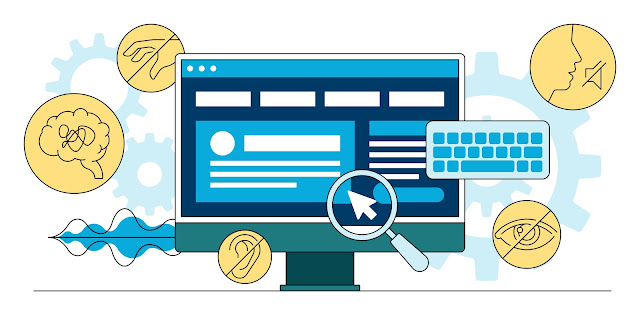Accessibility is a human right. In most countries, it is a law. Thus, most physical stores and services are legally required to make accessible features to those with disabilities. Today, however, as more people become more reliant on the internet, accessibility is no longer limited to the physical world.
It has become an essential feature in the virtual landscape with developers designing web accessibility. That said, this article will give you a basic introduction to web accessibility.
Web Accessibility: What Is It?
According to the World Wide Web Consortium (W3C), web accessibility refers to any practice of removing barriers that prevent access to, or seamless interaction with websites, by impaired or disabled individuals. When websites are correctly designed and developed for accessibility, all users can access functionality and information equally.
In short, web accessibility is all about creating a web design, content, and tools that everyone can use, regardless of ability.
Individuals With Disability On The Web
According to the World Health Organization (WHO), over a billion people in the world have a disability. While not all disabilities impact internet use, it would still be unwise to purposely exclude about 15% of the world’s population by not designing for accessibility.
In general, the types of disability you need to cater to on your website include:
- Visual: Color-blindness, low vision, blindness, etc.
- Auditory: Hearing difficulties and deafness.
- Cognitive: Easily distracted, learning disabilities, inability to focus or remember a large amount of information.
- Motor: Slow response time, inability to use a mouse or keyboard, limited fine motor control.
Each type of disability will require deliberate strategy in content and web design. Often, these strategies need to promote overall usability, for instance, using transcripts and captions or helpful illustrations.
Web Accessibility As A Legal Requirement
As mentioned in the introduction, accessibility is the law, not only in physical space but also in the virtual landscape. Most countries have web accessibility legislation in place–either based on W3C’s Web Content Accessibility Guidelines (WCAG) or standards that are built upon these guidelines.
Some of this legislation includes the following:
EAA
The European Accessibility Act is an EU directive requiring EU member states to legislate on accessibility both offline and online, providing a framework of standard accessibility rules for the market.
ADA
The Americans with Disabilities Act (ADA), Title III, states that all areas of public accommodation, including websites, should be accessible to all users.
AODA
The Accessibility for Ontarians with Disabilities Act (AODA) 2005 aims to identify, prevent, and remove barriers for Ontario residents with disabilities and includes web accessibility.
Australian DDA
The Australian Disability Discrimination Act (DDA) 1992 helps protect disabled people against discrimination across different situations in public life, including providing of online services and information via the web.
Accessibility laws and regulations make websites more accessible. However, they’re also protecting the rights of people with disabilities and impairments on the internet. Lawsuits have proven that you should take accessibility seriously. In fact, different people with disabilities have already sued companies due to their inaccessible websites.
The Importance Of Web Accessibility
As mentioned before, 15% of the world’s population is disabled. Rates of disability are only set to increase because of the aging population and the increase in chronic health problems. With the increasing number of disabled people, it only makes sense to design a more accessible and inclusive website.
Disabled people should enjoy the same access to online services and information as those without. Fortunately, web design strategies and technologies can help reduce or eliminate the barriers to their digital and web access. The provision of such processes and technologies ensures that everyone, regardless of mental or physical capabilities, can use your website and have a positive experience.
Other than making the web a more inclusive place for everyone, having a good web accessibility strategy can also bring business benefits. Accessibility is an essential component of development and design that impacts almost every element of the web creation process. It intersects the aspects of device independence, mobile-friendly designs, usability, multi-modal interaction, SEO, and so much more.
By designing a more accessible website, you can reduce maintenance costs, boost audience reach, gain better search results and rankings, and demonstrate corporate social responsibility. This means that website accessibility makes your site available to those with disabilities and helps improve the user experience for those with impairments and disabilities and for all users of your site.
The Four Web Accessibility Principles
WCAG and other accessibility standards state four main principles which serve as a good foundation of content produced for an accessible website. These four principles, also known as POUR, can serve as guidelines you can use and implement on your website.
P – Perceivable
A visitor should be able to perceive, be aware of or understand the content on your website. Take note that to ‘perceive’ doesn’t necessarily mean ‘to see with your eyes.’ While most web users perceive things based on visuals, for those who have low vision or are blind, touch and sound elements such as screen reader software are used instead.
O – Operable
You can use an operable website without disrupting a user in any way. This means that all visitors can efficiently utilize every part of the website’s functionality, from page navigation to playing audio or video.
In general, the most operable sites are straightforward, using necessary functions such as voice commands to help a disabled user.
U – Understandable
A user should easily understand all website content. Users should have no issue comprehending the purpose and meaning of information presented in the content. It should also apply to the site’s structure with pages neatly organized and navigation that’s intuitive and easy to follow.
R – Robust
Website robustness refers to the ability for your content to function reliably even with a wide variety of technologies such as assistive devices and software like screen readers.
Takeaway
Whether you’re running a simple commercial blog website or an eCommerce store, you have the responsibility to make sure that everyone, including those with impairments and disabilities, can use what you create. This is what accessibility is all about.
Developing an accessible and inclusive website can help create a memorable and positive user experience. Ultimately, it is the right thing to do for the people who matter most to your business–your customers and audience.
Raymond Brown is a website developer with over 10 years of experience. He shares his knowledge and expertise in his field by writing blogs. In his free time, Raymond loves to travel.

